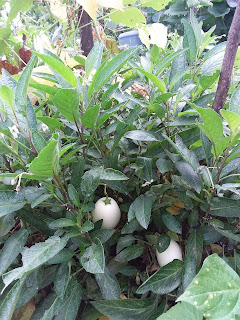Writer: Nirajan Panthee
Completed Diploma in Agriculture in Plant science from Jiri Technical School Jiri, Dolakha (CTEVT)
Current: Student of Valley Krishi Campus Chapagaun, Lalitpur (AFU Affiliated) BSc AG 1st semester
Pepino melon belongs to the Solanaceae family. Pepino melon is a juicy, delicious, pleasantly fragrant berry grown in the hilly region. It is an annual plant, semi-dense, small shrub reaching about 1-2 meters tall height. It flourishes well in well-drained loam soil. Light-blue flowers bloom which develop into fruits in 30-50 days. The fruits generally, are in light yellow color, smooth surface with purple stripe, ovate to elongated and weight about 300-500 grams. Inside, its smooth, juicy, cream textured flesh is sweet. The seeds are edible. Fruit from the growing pepino plants may be round, oval or even pear shaped and may be white, purple, green or ivory in color with purple striping. The flavor of the pepino fruit is similar to that of a honeydew melon, hence its common name of pepino melon, which can be peeled and eaten fresh.
Health benefits of pepino melon:
Pepinos are low calorie fruits with dietary-fiber, minerals and vitamins.
The antioxidants present in pepinos are scientifically found to be anti-inflammatory, skin-protective and may help prevent from cancers.
Consumption of natural vegetables and fruits rich in flavonoids is known to help protect from lung and oral cavity cancers.
Fresh fruit has moderate amounts of vitamin-C. Consumption of foods rich in vitamin-C helps the body develop resistance against infectious agents and scavenge harmful free radicals.
Fresh pepino melon is moderately good source of potassium. Potassium is an important component of cell and body fluids that helps controlling heart rate and blood pressure caused by sodium.
Further, they carry average levels of vital B-complex vitamins such as thiamin, niacin, folic acid, riboflavin as well some minerals like phosporus, iron, calcium, manganese and trace elements.
In traditional medicines, pepino thought to possess antirheumatic properties. It is also thought to be useful for treating respiratory infections and various skin problems.
Pepinio melon growing tips:
Pepino melon can be grown in the low and mid hills of our country generally from 500m -1800 m.
Pepino plants may be grown in sandy, loamy or even heavy clay soils, although they prefer alkaline, well-draining soil with an acid neutral pH. Pepinos should be planted in sun exposure and in moist soil.
Cutting should be placed in rooting medium having 1:1:1 soil-sand –FYM for good rooting. After 15-20 days plants are ready to shift in main field in spacing of 1m*1m spacing for good yield.
Sow the pepino seeds in the early spring indoors or in a warm greenhouse. Once they have attained enough size to transplant, transfer into individual pots but keep them in the greenhouse for their first winter. Once they are a year old, transfer the pepino plants outside to their permanent location in the late spring or early summer after the danger of frost has passed. Protect from frost or cold temperatures. Overwinter indoors or inside the greenhouse.
Pepino plants do not set fruit until the night temperatures are over 65 F. (18 C.). The fruit matures 30-80 days after pollination. Harvest the pepino fruit just before it is fully ripe and it will store at room temp for several weeks.
The plant will flower from August to October and fruit appears from September through November. There are many cultivars of pepino, so the appearance may vary.
There is necessary of lots of research work and extension work from Nepal government, Ministry of agriculture and National agriculture research council for the prospects of pepino melon in Nepal and commercial cultivation of this fruit.
(Ide, P. (2013). Health secret of Pepino. Elex Media Komputindo.)
(Mahato, S. K., Gurung, S., Chakravarty, S., Chhetri, B., & Khawas, T. (2016). An introduction to Pepino (Solanum muricatum Aiton). International Journal of Environment, Agriculture and Biotechnology, 1(2), 238513.)









No comments:
Post a Comment